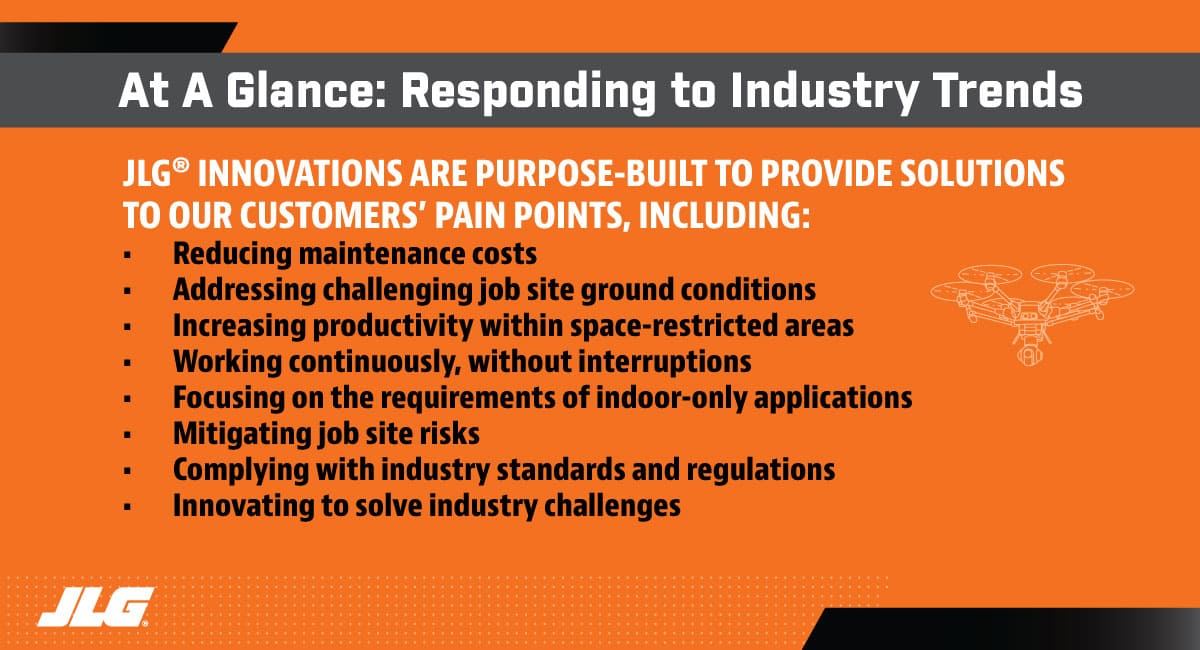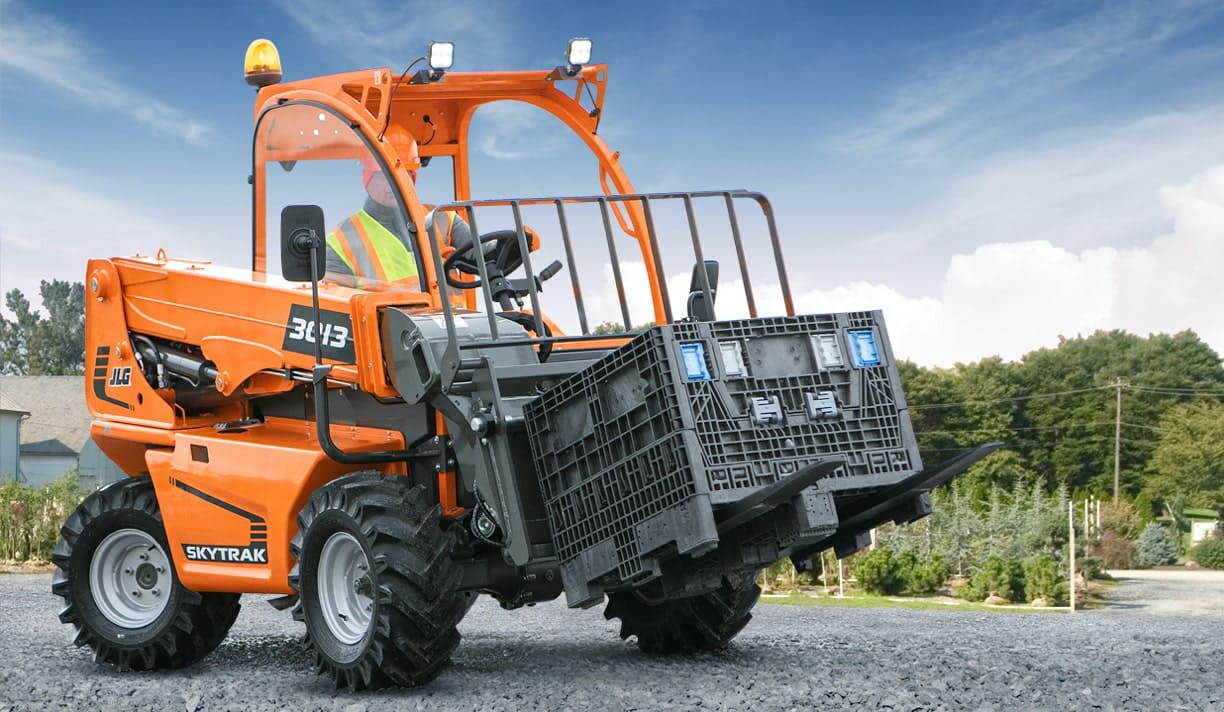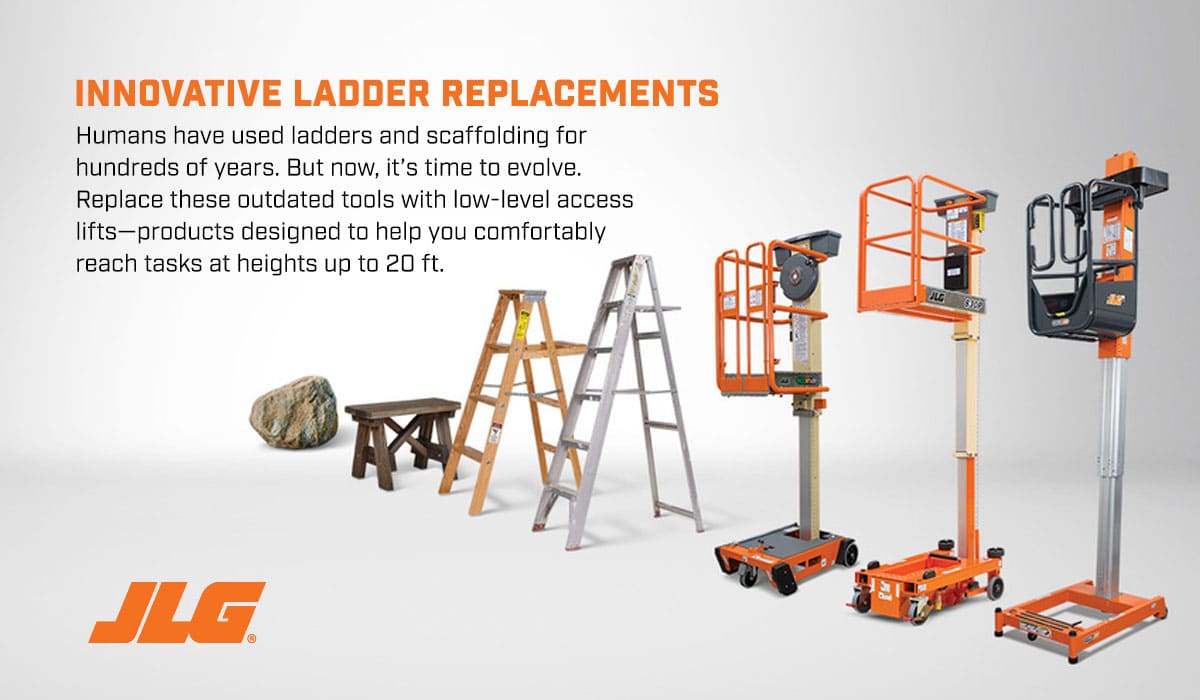One of the biggest responsibilities we have today as the leading global aerial equipment manufacturer is the need to continually evolve and introduce technologies and features that will enable our customers to be more successful, safer and increasingly efficient on the job.

By understanding the needs of our customers and what they expect from us, we are able to focus on developing enhancements that make JLG® equipment safer and more intuitive to operate. As I mentioned in a previous post, at JLG, we do this by focusing on elevating the access industry in three key areas: Productivity, Safety and Technology.
These aren’t just ideals we strive for — we approach and apply these principles to everything we do in a very strategic way. Here’s how we do that: It starts with watching industry trends. But it’s not just passively watching — it’s also actively working to understand how our customers are using JLG equipment in the field, as well as how industry trends are impacting and will influence work at height in the future.
The pain points we observe directly drive our innovation process. We like to call this “customer-inspired innovation.” And, our recent innovations have provided specific solutions for issues we discovered across multiple job sites around the world, including the need to:
- Reduce maintenance costs
- Address challenging job site ground conditions
- Increase productivity within space-restricted areas
- Work continuously, without interruptions
- Meet the requirements of indoor-only applications
- Mitigate job site risks
- Comply with industry standards and regulations
- Innovate to solve industry challenges
Reduced Maintenance
When it comes to scissor lifts, for example, we have observed that leaks and battery issues are two of the biggest culprits to downtime, so we have innovated two solutions that mitigate these challenges: Our new Davinci AE 1932 model and its single lithium-ion battery power source.
The JLG DaVinci™ AE (All Electric) 1932 scissor lift is the first fully electric model of its kind. Every component of the machine is optimized, allowing it to be powered with a single lithium-ion battery without a compromise to performance. It even recovers energy while the platform is being lowered, which contributes to a 70% decrease in power consumption and a longer battery life per charge.
This models’ single lithium-ion battery is backed by a class-leading warranty and is expected to last 120-plus months, so owners should never have to replace a battery during the machine’s lifespan.
And because its fully electric, the DaVinci AE1932 has zero hydraulics, so it eliminates leaks altogether and minimizes maintenance costs. It is a progressive, environmentally friendly solution that comes just as demand is building for electrified products, which I will discuss more in the following points.
Because its fully electric, the DaVinci All-Electric AE1932 Scissor Lift has zero hydraulics, so it eliminates leaks altogether and minimizes maintenance costs.
Ground Conditions
Another innovation that resulted from job site observation is our new self-leveling technology. JLG engineers recognized that traditional boom lifts were designed for the near ideal conditions of firm, flat surfaces. Since the world is neither flat, nor does much of it come with improved surfaces, they began exploring the viability of a boom lift with a smart suspension.
The result is our new 670SJ Self-Leveling Boom, which allows the boom lift to traverse uneven ground up to 10-degrees, while keeping the chassis level. This results in decreased platform movement during travel for greater operator comfort and confidence and full functionality while driving at height for greater productivity.
Space Restrictions
Urbanization is another driver of some of the equipment trends we are seeing. With less and less open space, buildings are becoming taller and space between them narrower. With that, the demand for smaller machines with compact footprints and higher reaching equipment is growing.
For example, with telehandlers customers told us they wanted a 10,000-lb telehandler with greater height and reach. We developed the JLG 1075, 75-ft boom, 8-story lift height telehandler as a result. It delivers a full two stories more lift height than comparable models and offers a 60-ft horizontal reach so operators can place materials exactly where they are needed, minimizing rehandling. This new telehandler has the advantages of a crane without the high, associated rental and assembly costs.
Customers also told us they needed telehandlers with a compact footprint and up-and-over reach. Our response: The SkyTrak® 3013 telehandler — an ideal machine solution for areas where space is restricted, yet greater lift height and horizontal reach are required. With its lift height of 13 ft and lift capacity of 2,700 lb, we designed it to be well-suited for loading and unloading material from trucks in urban and suburban applications. And because it only weighs 5,280 lb, it is also designed for easy transport by a work truck and trailer.

Continuous Work
An increase in online shopping is resulting in more and more warehouse construction. This type of construction oftentimes requires placement of cabling or wiring at a continuous height along the length of a building.
Our new line of rough terrain and electric rough terrain scissor lifts were designed with this in mind. They come in 26-, 33-, 40- and 47-ft platform heights, offering up to a 5-story work height and feature indoor/outdoor drive at full height capabilities.
These scissor lifts also include the industry’s first platform control box with an intuitive, LCD display that delivers a multitude of productivity, terrain, machine health and safety notifications to the operator during use. It even allows them to see the max height they can reach before elevating based on side-to-side and front-to-back tilt and the actual weight in the platform.
Indoor Site Restrictions
Data center construction is also on the rise. This type of indoor work often requires lightweight, environmentally friendly machines that can be operated in confined areas or on suspended floors with weight restrictions and in between sensitive storage systems, servers and application delivery controllers.
In response, JLG introduced two new indoor/outdoor rated, lightweight electric drive models: The ES1330L and the ES1530L. We also offer the indoor only, hydraulic drive model: The R1932i. QuickFold rails offer added versatility for movement of the lift in and through tight spaces.
Reducing Risk
And last but not at all least, I’d be remiss if I didn’t mention our range of Low-Level Access solutions. These products are gaining in popularity as company’s seek to mitigate worksite injuries associated with slips, trips and falls from ladders. This is just another area in which JLG is working to advance job site safety.

Industry Compliance
Our philosophy to regulatory compliance is to do more than merely satisfy the requirements. For example, the new ANSI 92 suite of standards has driven greater commonality among aerial equipment which means in today’s market, North America MEWPs (Mobile Elevating Work Platforms) are now more closely aligned with those sold around the world, particularly Europe, Australia, and China. This commonality should facilitate easier transactions around the sale of new and used equipment globally as the population of ANSI 92 compliant models expand.
We also see the impending Stage V engine regulations in Europe accelerating the drive towards electrified products. The maintenance costs for diesel engines will go up with the introduction of Stage V, as diesel particulate filters (DPF) will be required. While engine costs are escalating, lithium-ion battery costs are coming down. Because lithium powered products are both greener and less costly, with little to no compromise to performance, they are becoming more popular. As a result, we expect to see less demand for internal combustion-powered models in the future, so we will continue to innovate around electric-powered aerial products that drive a lower total cost of ownership.
Solving Challenges
As you can see, the products we have today not only respond to industry trends in the market, but they are also designed to simplify or reduce overall maintenance. This not only improves TCO (total cost of ownership), but it also aids the industry’s labor shortage, particularly mechanics.
Another way we are addressing the industry’s labor shortage is by innovating around moments of autonomy. The intent here is to bring to market products such as lift assist devices that make repetitive, manual labor less prone to injury across a five-generation deep workforce and provide solutions that aid the skilled labor shortage.
These are just a few ways JLG is working to ensure that the aerial industry eco-system remains healthy for the long term.
You can find more information on how JLG is addressing industry trends here.
Want to stay up to date with industry news and trends similar to this? Make sure you subscribe below to receive monthly updates from Direct Access with newly posted content so you never miss important information.